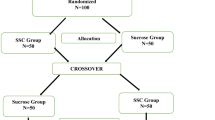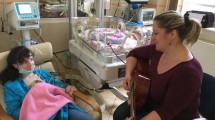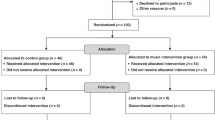Abstract
Objective:
To test if enhancing maternal skin-to-skin contact, or kangaroo mother care (KMC) by adding rocking, singing and sucking is more efficacious than simple KMC for procedural pain in preterm neonates.
Study Design:
Preterm neonates (n=90) between 32 0/7 and 36 0/7 weeks' gestational age participated in a single-blind randomized crossover design. The infant was held in KMC with the addition of rocking, singing and sucking or the infant was held in KMC without additional stimulation. The Premature Infant Pain Profile was the primary outcome with time to recover as the secondary outcome. A repeated-measures analysis of covariance was employed for analyses.
Result:
There were no significant differences in any of the 30 s time periods over the 2 min of blood sampling nor in time to return to baseline. Compared to historical controls of the same age in incubator, the pain scores were lower and comparable to other studies of KMC. There were site differences related to lower scores with the use of sucrose in one site and higher scores in younger, sicker infants in another site.
Conclusion:
The sensorial stimulations from skin-to-skin contact that include tactile, olfactory sensations from the mother are sufficient to decrease pain response in premature neonates. Other studies showing that rocking, sucking and music were efficacious were independent of skin-to-skin contact, which, when used alone has been shown to be effective as reported across studies.
This is a preview of subscription content, access via your institution
Access options
Subscribe to this journal
Receive 12 print issues and online access
$259.00 per year
only $21.58 per issue
Buy this article
- Purchase on Springer Link
- Instant access to full article PDF
Prices may be subject to local taxes which are calculated during checkout



Similar content being viewed by others
References
Gray L, Watt L, Blass EM . Skin-to-skin contact is analgesic in healthy newborns. Pediatrics 2000; 105 (1): e14.
Johnston CC, Stevens B, Pinelli J, Gibbins S, Filion F, Jack A et al. Kangaroo care is effective in diminishing pain response in preterm neonates. Arch Pediatr Adolesc Med 2003; 157 (11): 1084–1088.
Ludington-Hoe SM, Hosseini R, Torowizc DL . Skin-to-skin contact (kangaroo care) analgesia for preterm infant heelstick. AACN Clin Issues 2005; 16 (3): 373–387.
Porter RH, Winberg J . Unique salience of maternal breast odors for newborn infants. [Review] [119 refs]. Neurosc Biobehav Rev 1999; 23 (3): 439–449.
Hepper PG . Memory in utero? [see comment]. [Review] [60 refs]. Dev Med Child Neurol 1997; 39 (5): 343–346.
Korner AF, Lane NM, Berry KL, Rho JM, Brown Jr BW . Sleep enhanced and irritability reduced in preterm infants: differential efficacy of three types of waterbeds. J Dev Behav Pediatr 1990; 11: 240–246.
Campos RG . Rocking and pacifiers: two comforting interventions for heelstick pain. Res Nurs Health 1994; 17 (5): 321–331.
Johnston CC, Stremler RL, Stevens BJ, Horton LJ . Effectiveness of oral sucrose and simulated rocking on pain response in preterm neonates. Pain 1997; 72: 193–199.
Johnston CC, Filion F, Nuyt AM . Recorded maternal voice for preterm neonates undergoing heel lance. Adv Neonatal Care 2007; 7 (5): 258–266.
Carbajal R . Crossover trial of analgesic efficacy of glucose and pacifier in very preterm neonates during subcutaneous injections. Pediatrics 2002; 110 (2 Part 1): 389–393.
Stevens B, Johnston C, Franck L, Petryshen P, Jack A, Foster G . The efficacy of developmentally sensitive interventions and sucrose for relieving procedural pain in very low birth weight neonates. Nurs Res 1999; 48 (1): 35–43.
Mathai S, Natrajan N, Rajalakshmi NR . A comparative study of nonpharmacological methods to reduce pain in neonates. Indian Pediatr 2006; 43 (12): 1070–1075.
Bellieni CV, Buonocore G, Nenci A, Franci N, Cordelli DM, Bagnoli F . Sensorial saturation: an effective analgesic tool for heel-prick in preterm infants: a prospective randomized trial. Biol Neonate 2001; 80 (1): 15–18.
Zeifman D, Delaney S, Blass EM . Sweet taste, looking, and calm in 2-and-4-week-old infants: the eyes have it. Dev Psychol 1996; 32 (6): 1090–1099.
Gormally S, Barr RG, Wertheim L, Alkawaf R, Calinoiu N, Young SN . Contact and nutrient caregiving effects on newborn infant pain responses. Dev Med Child Neurol 2001; 43 (1): 28–38.
Dupont W . Power calculations for matched case–control studies. Biometrics 1988; 44: 1157–1168.
Stevens BJ, Johnston C, Petryshen P, Taddio A . Premature Infant Pain Profile: development and initial validation. Clin J Pain 1996; 12 (1): 13–22.
Stevens BJ, Johnston CC, Franck LS, Petryshen P, Jack A . Validation of the Premature Infant Pain Profile (PIPP) with very low birthweight neonates International Pediatric Nursing Research Symposium on Clinical Care of the Child and Family. 8. 1999. Ref Type: Abstract.
Stevens BJ, Pillai Riddell R, Oberlander TE, Gibbins S . Assessment of pain in neonates and infants In: Anand KJS, Stevens BJ, McGrath PJ (eds). Pain in Neonates and Infants. 3 edn Elsevier: Toronto, 2007 pp 67–90.
Prechtl HFR . The behavioral states of the newborn infant: a review. Brain Res 1974; 76: 185–212.
Prechtl HF . The organization of behavioral states and their dysfunction. Seminars in Perinatology 1977; 16 (4): 258–262.
Richardson DK, Corcoran JD, Escobar GJ, Lee SK . SNAP-II and SNAPPE-II: simplified newborn illness severity and mortality risk scores. J Pediatr 2001; 138 (1): 92–100.
Cignacco E, Hamers JPH, Stoffel L, van Lingen RA, Gessler P, McDougall J et al. The efficacy of non-pharmacological interventions in the management of procedural pain in preterm and term neonates. A systematic literature review. [References]. Eur J Pain 2007; 11 (2): 139–152.
Graven SN . Early neurosensory visual development of the fetus and newborn. [Review] [36 refs]. Clin Perinatol 2004; 31 (2): 199–216.
Fleming AS, O'Day DH, Kraemer GW . Neurobiology of mother–infant interactions: experience and central nervous system plasticity across development and generations. [Review] [106 refs]. Neurosci Biobehav Rev 1999; 23 (5): 673–685.
Modrcin-Talbott MA, Harrison LL, Groer MW, Younger MS . The biobehavioral effects of gentle human touch on preterm infants. Nurs Sci Q 2003; 16 (1): 60–67 Jan (28 ref).
Marlier L, Gaugler C, Astruc D, Messer J . [The olfactory sensitivity of the premature newborn]. [Review] [64 refs] [French]. Archives de Pediatrie 2007; 14 (1): 45–53.
Goubet N, Strasbaugh K, Chesney J . Familiarity breeds content? Soothing effect of a familiar odor on full-term newborns. J Dev Behav Pediatr 2007; 28 (3): 189–194.
Johnston CC, Filion F, Campbell-Yeo M, Goulet C, Bell L, Finley GA et al. Kangaroo mothercare diminishes pain from heel lance in very preterm neonates: a crossover trial. BMC Pediatr 2008; 8: 13 In press.
Moore ER, Anderson GC, Bergman N . Early skin-to-skin contact for mothers and their healthy newborn infants [systematic review]. Cochrane Database Syst Rev 2007; (4): CD003519.
Ramanathan K, Paul VK, Deorari AK, Taneja U, George G . Kangaroo mother care in very low birth weight infants. Indian J Pediatr 2001; 68 (11): 1019–1023.
Charpak N, Ruiz-Pelaez JG, Figueroa de CZ, Charpak Y . A randomized, controlled trial of kangaroo mother care: results of follow-up at 1 year of corrected age. Pediatrics 2001; 108 (5): 1072–1079.
Bystrova K, Widstrom AM, Matthiesen AS, Ransjo-Arvidson AB, Welles-Nystrom B, Wassberg C et al. Skin-to-skin contact may reduce negative consequences of ‘the stress of being born’: a study on temperature in newborn infants, subjected to different ward routines in St. Petersburg. [see comment]. Acta Paediatr 2003; 92 (3): 320–326.
Feldman R, Weller A, Sirota L, Eidelman AI . Testing a family intervention hypothesis: the contribution of mother–infant skin-to-skin contact (kangaroo care) to family interaction, proximity, and touch. J Fam Psychol 2003; 17 (1): 94–107.
de Macedo EC, Cruvinel F, Lukasova K, D'Antino ME . The mood variation in mothers of preterm infants in kangaroo mother care and conventional incubator care. J Trop Pediatr 2007; 53 (5): 344–346.
Hofer MA . Early relationships as regulators of infant physiology and behavior. [Review] [49 refs]. Acta Paediatr Suppl 1994; 397: 9–18.
Johnson AN . Factors influencing implementation of kangaroo holding in a special care nursery. MCN Am J Matern Child Nurs 2007; 32 (1): 25–29.
Moore ER, Anderson GC, Bergman N . Early skin-to-skin contact for mothers and their healthy newborn infants. [update of Cochrane Database Syst Rev. 2003;(2):CD003519; PMID: 12804473]. [Review] [111 refs]. Cochrane Database Syst Rev 2007; (3): CD003519.
Acknowledgements
This project was sponsored by the Canadian Institutes of Health Research (CIHR; MOP 117475-CHI-CFAA-23682 ) and additional support from Fonds de la Recherche en Santé du Québec (FRSQ). CJ is a member of the McGill University Health Centre Research Institute that is funded by FRSQ. We thank the babies, parents and staff of the NICUs at Hopital Ste Justine, Montreal, Royal Victoria Hospital, Montreal and IWK Children's Health Centre, Halifax. Canada. We especially thank research nurses Terry Suss and Kim Caddell for the meticulous attention to the protocol and sensitive recruitment of mothers. Thanks also to research assistants Indrayudh Ghoshal and Elaine Tam. We thank the 3M Company for the provision of red dot electrodes, and for the ‘puppy dog’ electrodes, we thank Tyco Medical Canada.
Author information
Authors and Affiliations
Corresponding author
Additional information
Authours' contributions. CJ was responsible for all stages of the study. FF, MCY, LB participated in the protocol development, oversaw data collection from one site, participated in data analysis and paper preparation and review. CG participated in study design, and KM, JB trained and oversaw data coding, data entry and verification, literature review update and paper preparation.
Rights and permissions
About this article
Cite this article
Johnston, C., Filion, F., Campbell-Yeo, M. et al. Enhanced kangaroo mother care for heel lance in preterm neonates: a crossover trial. J Perinatol 29, 51–56 (2009). https://doi.org/10.1038/jp.2008.113
Received:
Revised:
Accepted:
Published:
Issue Date:
DOI: https://doi.org/10.1038/jp.2008.113
Keywords
This article is cited by
-
Study protocol: parents as pain management in Swedish neonatal care – SWEpap, a multi-center randomized controlled trial
BMC Pediatrics (2020)
-
Effect of combined music and touch intervention on pain response and β-endorphin and cortisol concentrations in late preterm infants
BMC Pediatrics (2017)
-
Effects of standardized acoustic stimulation in premature infants: a randomized controlled trial
Journal of Perinatology (2016)
-
Les soins centrés sur l’enfant et sa famille et le modèle du couplet care scandinave : un modèle applicable à la France ?
Revue de médecine périnatale (2016)



